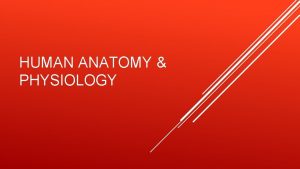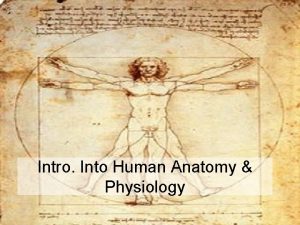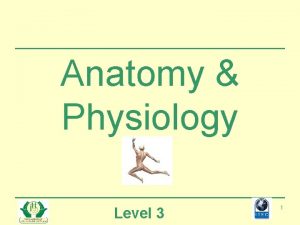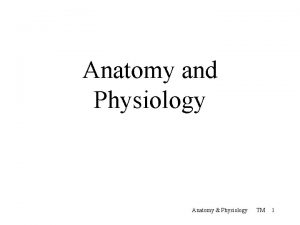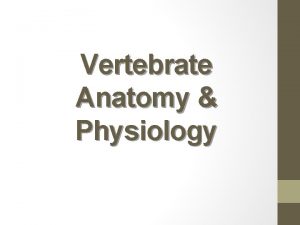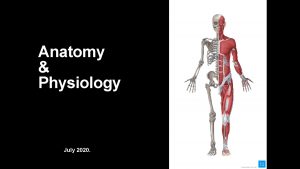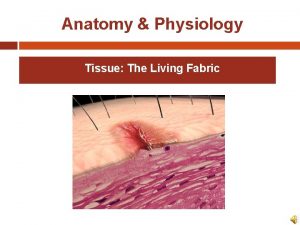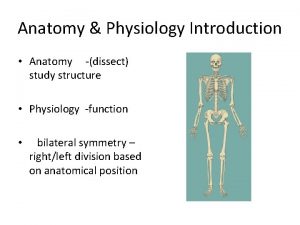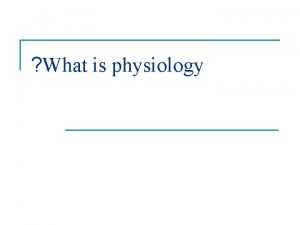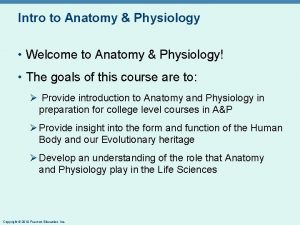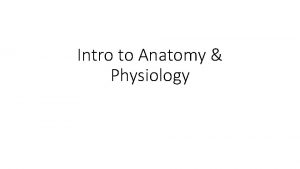Anatomy Physiology and Disease Chapter 2 The Human













































- Slides: 45

Anatomy, Physiology and Disease Chapter 2 The Human Body: Reading the Map

“I Have Pain in my Stomach” What exactly does the patient mean? Exactly where is the pain? Ø Does it move or travel to other parts of the body? Ø When did it start? Ø What is the intensity? on a 1 -10 scale… Ø Is it sharp, dull, achy, or cramping…? Ø Does the patient really mean abdomen for stomach? Ø Questions about type of pain, exact location, and intensity of pain can help determine etiology Ø Food Menstrual Labor Appendicitis Trauma I don’t know!

The Anatomical Position Ø The person is standing erect, face forward, with feet parallel, arms hanging at sides, and palms facing forward

Other Body Positions Supine position: laying face upward, on your back Ø Prone position: laying face downward, on your stomach Ø Fowler’s position: sitting in bed with head of bed elevated 45– 60 degrees Ø Trendelenberg Prone Supine Fowler’s

Trendelenburg Prone Supine Fowler’s

Pathology Connection Ø Trendelenburg - helps to drain secretions from base of lungs - avoid with brain injury patients as it will increase intracranial pressure. - are at increased risk for aspirating vomitus, and should not eat within 2 -4 hours of being placed in position. - Patients with orthopnea have difficult time breathing if they lie flat.

Pathology Connection con’t Ø JVD: Jugular Vein Distention - distend neck veins due to heart failure

Pathology Connection con’t Ø Orthostatic Hypotension - Dizziness when changing from seated to standing position.

Body Planes and Directional Terms Plane - an imaginary line drawn through body or organ to separate into specific sections. Ø Transverse or horizontal plane - divides body into superior (top) and inferior (bottom) sections, also referred to as cross-sectioning the body. Ø Superior (cranial or cephalic) means toward head or upper body. Ø Inferior (caudal) means away from head or toward lower part of body. Ø

Transverse or Horizontal Plane Superior view

Median or Midsagittal Plane Ø Divides body into right and left halves l l Medial refers to body parts located near middle or midline of body. Lateral refers to body parts located away from midline. Sagittal view

Frontal or Coronal Plane Divides body into front and back sections Ø Anterior or ventral refers to body parts towards or on front of body Ø Posterior or dorsal refers to body parts towards or on back of body Ø Frontal View

Proximal and Distal Proximal - refers to body parts close to point of reference of body. Ø Distal - refers to body parts away from point of reference. Ø

External and Internal External means on the outside l Skin is located externally and is body’s largest organ Ø Internal means on the inside l Most organs located internally Ø

Additional Directional Terms Superficial means toward or at body surface Ø Deep means away from body surface Ø Central refers to locations around center of body Ø Peripheral refers to extremities or outer region Ø


Body Location Terms

Body Cavities Body has two large open spaces called cavities that house and protect organs Ø Dorsal (posterior) cavity located on back of body Ø Ventral (anterior) Larger cavity located on front of body is divided into two smaller cavities l Thoracic cavity l Abdominopelvic cavity: further divided into abdominal and pelvic cavities Ø These two smaller cavities are divided by the diaphragm Ø

Main Body Cavities

Main Body Cavities

Thoracic Cavity Ø Contains l l l Heart Lungs Large blood vessels

Abdominal Cavity Ø Contains digestive organs l l l Stomach Intestines Liver Gallbladder Pancreas Spleen

Pelvic Cavity Ø Lower portion of abdominopelvic cavity contains l Urinary organs l Reproductive organs l Large part of large intestine

Dorsal Cavity Ø Located in back of body and consists of two cavities l Cranial cavity houses brain l Spinal cavity contains spinal column

Review of Body Cavities

Review of Body Cavities

Smaller Cavities Nasal cavity: space behind nose Ø Buccal cavity: space within mouth Ø Orbital cavity: houses eyes Ø Nasal Buccal Orbital

Abdominal Regions

Illustrations of inguinal and umbilical hernias

Abdominal Quadrants Simpler way to compartmentalize abdominal region is to separate into anatomical quadrants Ø Helpful in describing location of abdominal pain Ø

Abdominal Pain Ø Knowing organs located in quadrant where pain is arising can give a clue as to what type of problem the patient has l Right lower quadrant (RLQ) pain: appendicitis l Right upper quadrant (RUQ) pain: liver or gallbladder problems l Right or Left flank pain: Renal calculi (Kidney stones) l Right or left inguinal pain: Renal calculi or hernia

The spinal column Cervical Column Vertebra 1 -7 (Neck) Ø Thoracic Column Vertebra 1 -12 (Chest) Ø Lumbar Column Vertebra 1 -5 (low Back) Ø Sacrum (fused) Vertebra 1 -5 (very low Back) Ø Coccyx: tail-bone Ø

Additional Body Regions

Body Regions

Body Regions cont.

X-Rays (Radiograph or Roentgenogram) Produced by passing X-ray radiation through body onto photographic film. Ø Exposure to X-rays causes photographic film to darken. Ø Radiolucent areas of body allow X-rays to pass through to film easily; produce dark areas on film. Ø Radiopaque areas of body allow fewer X-rays to pass through to film; produce light areas on the film.

X-Rays cont’d Each component of body has a characteristic density & appearance on X-ray. Air: least dense; shows up black on X-ray. Ø Tissue/Fat: density depends on thickness of tissue; thicker the tissue, lighter the appearance on X-ray. Ø Is this x-ray normal or abnormal? Why?

X-ray cont Water, Blood & Edema: mid-range density. Appearance is lighter than air, but not as white as bone/metal. Ø Bone/metal: highest density. Appears white on X-ray. Ø Is this x-ray normal or abnormal? Why?

Standard X-Ray Positions Ø Posteroanterior (PA) l l Ø X-ray beam passes from patient’s back to patient’s front and then onto film Standard view for chest Xray Anteroposterior (AP) l l X-ray beam passes from patient’s front to patient’s back and then onto film Often used in portable chest X-rays

Pneumothorax Is this a Left or Right Pneumothorax? Why?

Lateral Chest X-Ray Ø Lateral l X-ray beam passes from one side of patient to other, and then onto film l Often used as compliment to PA views, to get better 3 -D perspective Is this a Left or Right Lateral CXR? Why?

Computerized Tomography (CT or CAT Scan) Produces series of What view is cross-sectional this CTScan? “slices” through body Why? Ø Generates highresolution images with more information about 3 -D orientation of structures Ø Exposes body to much higher levels of radiation than What view is this CTScan? traditional X-ray Ø Why?

Magnetic Resonance Imaging (MRI) Uses magnetic energy to image body Ø Produces crosssectional images Ø Images have much better clarity than CT Ø What view are these MRIs? Why?

Magnetic Resonance Imaging (MRI) (cont’d) Ø Cannot be used by all patients l Patients with certain metallic components in body (like metallic aneurysm clips or heart valves) cannot be exposed to magnetic field of MRI; would make metal components shift in body l Patients who are claustrophobic may not be able to tolerate entering small tunnel of traditional (closed) MRI; open MRIs are alternative for these patients

Ultrasound (Sonography) Uses sound waves to image body Ø Allow body actions to be imaged in real time Ø Uses include: l Observing fetal development and movement l Observing actions of heart valves Ø Cardiac Ultrasound Abdominal Ultrasound
 Chapter 1 introduction to human anatomy and physiology
Chapter 1 introduction to human anatomy and physiology Distal and proximal
Distal and proximal Chapter 2 human reproductive anatomy and physiology
Chapter 2 human reproductive anatomy and physiology Human anatomy and physiology seventh edition marieb
Human anatomy and physiology seventh edition marieb Holes essential of human anatomy and physiology
Holes essential of human anatomy and physiology Uterus perimetrium
Uterus perimetrium Anatomy and physiology ninth edition
Anatomy and physiology ninth edition Chapter 14 anatomy and physiology
Chapter 14 anatomy and physiology Anatomy and physiology chapter 8 special senses
Anatomy and physiology chapter 8 special senses Chapter 13 anatomy and physiology of pregnancy
Chapter 13 anatomy and physiology of pregnancy Chapter 2 basic chemistry anatomy and physiology
Chapter 2 basic chemistry anatomy and physiology Anatomy and physiology chapter 7
Anatomy and physiology chapter 7 Chapter 14 the digestive system and body metabolism
Chapter 14 the digestive system and body metabolism Chapter 10 blood anatomy and physiology
Chapter 10 blood anatomy and physiology Anatomy and physiology chapter 15
Anatomy and physiology chapter 15 Anatomy and physiology chapter 1
Anatomy and physiology chapter 1 Holes anatomy and physiology chapter 1
Holes anatomy and physiology chapter 1 Anatomy and physiology chapter 15
Anatomy and physiology chapter 15 Anatomy and physiology chapter 8 skeletal system
Anatomy and physiology chapter 8 skeletal system Chapter 6 general anatomy and physiology
Chapter 6 general anatomy and physiology Cephalic cranial
Cephalic cranial Structure of the upper respiratory system
Structure of the upper respiratory system Tattoo anatomy and physiology
Tattoo anatomy and physiology Science olympiad anatomy and physiology
Science olympiad anatomy and physiology Specialized stems examples
Specialized stems examples Anatomy and physiology bones
Anatomy and physiology bones Pud
Pud Liver anatomy and physiology
Liver anatomy and physiology Epigastric region
Epigastric region Hypogastric region
Hypogastric region Straw coloured fluid
Straw coloured fluid Http://anatomy and physiology
Http://anatomy and physiology Physiology of appendix
Physiology of appendix Aohs foundations of anatomy and physiology 1
Aohs foundations of anatomy and physiology 1 Aohs foundations of anatomy and physiology 2
Aohs foundations of anatomy and physiology 2 Anatomical planes
Anatomical planes Teks anatomy and physiology
Teks anatomy and physiology Science olympiad anatomy and physiology 2020 cheat sheet
Science olympiad anatomy and physiology 2020 cheat sheet Anatomy and physiology of stomach ppt
Anatomy and physiology of stomach ppt Anatomy and physiology of pancreas in diabetes
Anatomy and physiology of pancreas in diabetes Aohs foundations of anatomy and physiology 1
Aohs foundations of anatomy and physiology 1 Aohs foundations of anatomy and physiology 1
Aohs foundations of anatomy and physiology 1 Anatomy and physiology
Anatomy and physiology Cornell notes for anatomy and physiology
Cornell notes for anatomy and physiology Anatomy and physiology unit 7 cardiovascular system
Anatomy and physiology unit 7 cardiovascular system Anatomy and physiology
Anatomy and physiology


















































